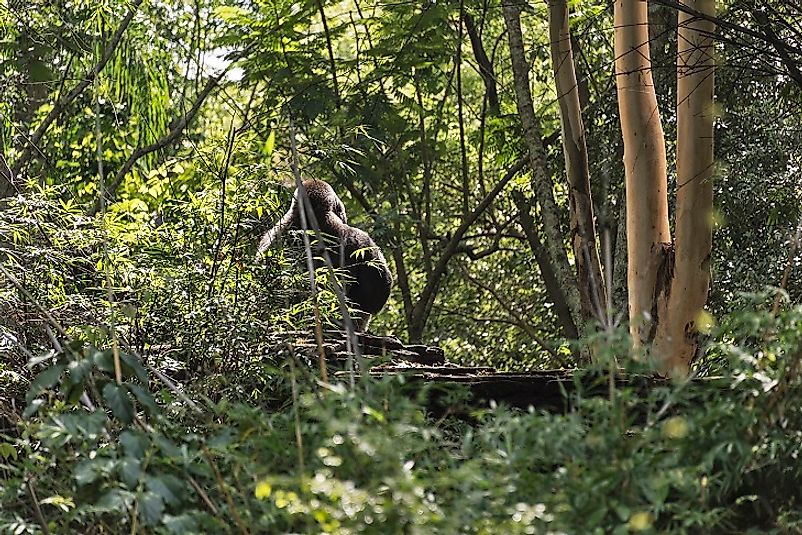Ecological Regions Of Equatorial Guinea

The West African nation of Equatorial Guinea is made up of the mainland region of Rio Muni and the islands of Bioko, Annabon, Corisco, Small Elobey, and Great Elobey. The country’s three inhabited territories are home to a rich biodiversity which mirrors that found in some of its neighbors such as Cameroon and Gabon. Equatorial Guinea’s mainland and offshore islands are covered in tropical moist forests and mangroves. The ecological regions of Equatorial Guinea are looked at below.
Ecological Regions Of Equatorial Guinea
Atlantic Equatorial Coastal Forests
The Atlantic Equatorial coastal forests ecological region is classified under the Tropical and Subtropical Moist Broadleaf Forests Biome. This ecoregion is native to Equatorial Guinea, Congo, Cameroon, Gabon, and the Democratic Republic of Congo. The ecoregion stretches along the Atlantic coast of these African countries and covers hills, plains and mountains. Abundant rainfall is recorded in the region, reaching an estimated 2,000 mm annually with limited seasonality. Temperatures range from a minimum of 18 to 21 degrees Celsius to a maximum of 24 to 27 degrees Celsius. The terrain of the region is marked by Precambrian metamorphic rocks including gneiss and schists. Flora and fauna in the ecoregion exhibit a high level of endemism. Over 4000 plant species have been identified in the region. The region supports some near-endemic mammals including the sun-tailed monkey, African smoky mouse, and long-footed shrew. Notably, the forest is home to gorillas, chimpanzees, and forest elephant. Although extensive forest areas remain intact in Equatorial Guinea, logging is a major threat to the forest’s sustainability. The Monte Alen National Park in the country serves to protect the region’s biodiversity.
Central African Mangroves
The Central African Mangroves ecological region is classified in the Mangroves Biome. The ecoregion lies in western Africa, along with the mangrove regions of the coastlines of Equatorial Guinea, Nigeria, Gabon, Angola, Cameroon, and the Democratic Republic of Congo. The mangroves inhabit various habitats from lagoons to river mouths. The region’s mangrove trees can grow to a maximum length of 45 meters. The red mangrove, white mangrove, black mangrove, Rhizophora harrisonii, and Rhizophora racemosa mangrove tree species characterize this ecoregion. The Nypa fruticans, an introduced tree species from Asia, also inhabits the region.
The Nile crocodiles, scalter’s monkey, hippopotamus, soft-skinned turtle and the West African manatee are some of the fauna found in this ecoregion. The region is also home to abundant fish species and is a migratory area for avian fauna.
Cross-Sanaga-Bioko Coastal Forests
The Cross-Sanaga-Bioko coastal forests ecoregion is classified in the Tropical and Subtropical Moist Broadleaf Forests Biome. This ecoregion stretches from the Cross River in Nigeria to the Sanaga River in Cameroon to the lowland forests of Bioko Island of Equatorial Guinea. The ecoregion is characterized by numerous rivers and has a wet climate. Humidity recorded in the region is always high, ranging from 90 to 100%.
Tree species in this region grow up to 50 meters and are mostly in the Sterculiaceae, Annonaceae, Rubiaceae, Leguminosae, and Euphorbiaceae families. Over 1,000 plant species have been identified in the lowland forests of Bioko. The endangered pallid needle-clawed galago and the pennant’s red colobus primate species inhabit the lowland forests of Bioko.
The lowland forests in Bioko are increasingly threatened by land transformation and farming activities. Hunting of animals has also rendered some species vulnerable and some as threatened.
Mount Cameroon and Bioko Montane Forests
The Mount Cameroon and Bioko montane forests are classified in the Tropical and Subtropical Moist Broadleaf Forests Biome. This ecoregion is native to the high elevations of the volcanic Mount Cameroon situated in Cameroon, and the volcanic island of Bioko in Equatorial Guinea.
The region is mainly characterized by montane grasslands and montane forests. Rainfall recorded in the area falls above 3,500 millimeters in a year. Average temperatures range from 25.5 to 27 degrees Celsius and reach between 32 to 35 degrees Celsius in the hottest months.
The ecoregion is particularly rich in avian fauna, much of which has been preserved in the Basile Peak National Park and the Luba Caldera Scientific Reserve. Animal species that roam in the region include the Einsentraut’s mouse shrew, black colobus monkey, Preuss’s monkey, and the red-eared nose-spotted monkey. Animal hunting and habitat loss have been identified as the main threats to this ecoregion.
Environmental Concerns in Equatorial Guinea
Other ecological regions in Equatorial Guinea include the Central West Coastal Equatorial, the Gulf of Guinea Central, the Gulf of Guinea Islands, the Northern West Coastal Equatorial-Bioko Island, the São Tomѐ, Príncipe and Annobón, and the moist lowland forests of São Tomѐ, Príncipe and Annobón Islands. Equatorial Guinea has some of Africa’s highest rates of logging. Environmentalists are increasingly alarmed over the impacts of logging, hunting of wildlife and marine contamination on the country’s ecological regions.
Ecological Regions Of Equatorial Guinea
| Ecological Regions of Equatorial Guinea | Biome |
| Atlantic Equatorial coastal forests | Tropical and Subtropical Moist Broadleaf Forests |
| Central African mangroves | Mangroves |
| Central West Coastal Equatorial | Freshwater |
| Cross-Sanaga-Bioko coastal forests | Tropical and Subtropical Moist Broadleaf Forests |
| Gulf of Guinea Central | Marine |
| Gulf of Guinea Islands | Marine |
| Mount Cameroon and Bioko montane forests | Tropical and Subtropical Moist Broadleaf Forests |
| Northern West Coastal Equatorial-Bioko Island | Freshwater |
| São Tomé, Príncipe, and Annobón moist lowland forests | Tropical and Subtropical Moist Broadleaf Forests |
| São Tomé, Príncipe, and Annobón Islands | Freshwater |











